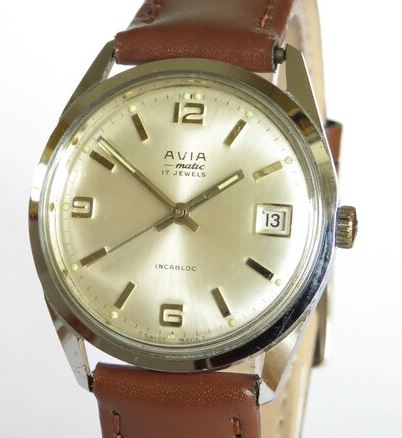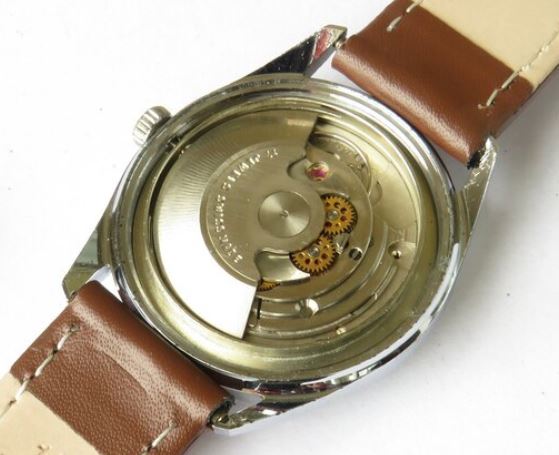Last Updated on June 29, 2024 by Jason
This vintage watch is an Avia-matic automatic watch dating from the 1960s. The watch has a Swiss 17-jewel ETA 2472 automatic movement, with Incabloc shock protection. The watch is working well and keeping good time. Avia is a watchmaking company that has a long history and was very prominent in the 1950s and 60s.
The Avia Watch Company
The Avia Watch Company traces its history back to 1887, when HV Degoumois founded it in La Chaux de Fonds, Switzerland. Later, in 1933, the company relocated to Neuchâtel. On January 30, 1937, the Avia brand was officially registered by Degoumois.
Avia gained recognition for producing high-quality mechanical lever movement watches. Their watch cases ranged from solid gold to gold-plated and stainless steel. Interestingly, Avia’s reputation extended beyond its own brand. They supplied watches and movements to other notable brands like A. Wittnauer & Co. and the Ball Watch Company.
In 1968, Avia became part of a consortium that included Invicta and Sandoz. This consortium also acquired Waltham (Chicago, USA). Together, they developed the world’s first quartz digital watch with an LCD display. Unveiled at the Basel Fair in 1972, this innovation revolutionized timekeeping by offering unparalleled accuracy at an affordable price.
The Avia digital watch gained immense popularity, even gracing the cover of the Horological Journal in 1975. However, as digital technology spread, luxury status waned. By the 1980s, digital watches were commonplace and inexpensive. Eventually, Avia was acquired by the Fossil Group, which continues to manufacture and sell Avia quartz watches today.

ETA 2472 movement
The ETA 2472 is a mechanical movement with automatic winding, a date display with a semi-quickset feature, and a power reserve of 42 hours. It is a high-quality movement with 17 jewels. The ETA 2472 movement features a semi-quickset date feature, more advanced than all other members of the ETA 2400 family apart from the similar hand-wound 2408. The date changes instantly at midnight. To set the date, the time is moved forward from 20:30 to 24:00, then back to 20:30 and forward again. The ETA 2472 movement was made between the years 1956 to 1974.

The 2472 was very popular due to its compact size and excellent performance. It was a state-of-the-art movement for much of the 1960s, with the bidirectional automatic winding, date feature, and direct central seconds cited as advances. The 18,000 A/h balance motion would quickly be eclipsed, but the 2472 was capable of chronometer-grade performance thanks to precise regulation using a moveable hairspring stud and long regulator arm. The service history is unknown.
Dial
The signed dial is in its original finish with original hands, centre seconds hand and date display. It has an early form of quickset which is initially set by moving the hands backwards and forwards between 12 midnight and 8.30 pm. It is a little cumbersome, but certainly better than rolling forward 24 hours. The watch has a signed Avia winding crown. The acrylic lens is in good condition. The dial is signed AVIA-matic, 17 jewels, Incabloc and “T Swiss Made T”.
“T Swiss Made T”
The “Swiss Made” marking indicates that the watch was manufactured in Switzerland under strict terms and conditions. It is a label or brand that represents quality in the watchmaking industry. It is also a geographical indication protected under different Swiss and international laws and treaties. The “T” on either side of the marking indicates that the luminescence on the dial is triggered by tritium, a radioactive element, reacting with the paint on the hands and hour markers. Tritium was used for luminescence from the 1960s until the 1990s. Although not as dangerous as radium, it still exposed users to a radioactive health risk. Today, watch manufacturers typically use non-radioactive luminescent materials such as Super-LumiNova or LumiBrite. These offer similar visibility in the dark without the health risks associated with radioactive substances like tritium.
Tritium has a half-life of about 12.3 years, which means that its radioactivity diminishes by half every 12.3 years. The luminosity of tritium-based luminescent materials typically lasts for around 10 to 20 years before the brightness noticeably diminishes. Any vintage “T Swiss Made T” watches are highly unlikely to show any practical luminescence.
Incabloc
The Incabloc shock protection system is the trade name for a spring-loaded mounting system for the jewel bearings that support the balance wheel in a mechanical watch. This is designed to protect the balance wheel’s delicate components from damage if the watch is subject to a sudden physical shock, such as if the watch is dropped. The Incabloc system was developed in 1934 by Swiss engineers Georges Braunschweig and Fritz Marti, at Universal Escapements, Ltd, in La Chaux-de-Fonds, Switzerland.
The pivots and jewel bearings that support the watch balance wheel are fragile in comparison to the weight they must support. Without shock protection, they are the parts of the watch most likely to be damaged from sudden shock. Before the widespread use of shock protection systems such as Incabloc, broken balance staffs were a common type of damage requiring watch repair.
The Incabloc system uses a “lyre-shaped” spring to allow the fragile bearings to move in their settings during impact until a stronger shoulder of the staff contacts the strong metal endpiece. This means that the pivots and bearings don’t have to bear the full force of the impact. When the impact is over, the springs guide the parts back to their original positions. The staff itself does not move relative to the jewel bearing, but the whole bearing is carried in a metal bushing that is free to move in the metal endpiece, under the control of the spring.
Case
The watch measures 34mm in diameter excluding the winding crown and the lugs. The main body of the case is chromium plated while the screw-on case back is stainless steel. There is a minor mark to the case but it is not too detrimental. The case back has some scratching where a tool has slipped in the past. The back of the watch states that it is waterproof but, as with any vintage watch, it should be kept away from water and moisture.
Leave a Reply